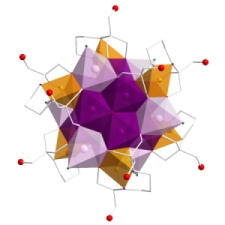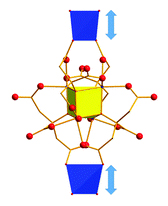Research - molecular magnetism
 Our main focus is in the area of molecular magnetism with future applications in magneto-optical switches and magneto-optical data storage, quantum computation, magnetic refrigeration, MRI contrast agents, molecular spintronics including molecular nanomagnet/carbon nanotube or graphene hybrids and ultra-high-density information storage.
Our main focus is in the area of molecular magnetism with future applications in magneto-optical switches and magneto-optical data storage, quantum computation, magnetic refrigeration, MRI contrast agents, molecular spintronics including molecular nanomagnet/carbon nanotube or graphene hybrids and ultra-high-density information storage.
Molecular magnets are at the cutting edge of modern coordination chemistry, these fascinating molecules can be used as tools to test magnetic theories and probe new magnetic phenomena at low temperature in the quantum regime.
Single-molecule magnets (SMMs)
We have a particular interest in the use of polydentate ligands to contol the assembly of nanomagnets, especially in the area of complex heterometallic systems e.g. Chem. Commun., 2017, 53, 4799, Chem. Eur. J., 2016, 22, 12839, Inorg. Chem., 2014, 53, 8970 and Angew. Chem. Int. Ed., 2013, 52, 1949 and in the use of ions such as Ni(II) and Co(II): e.g. Chem. Commun., 2007, 3473 and Inorg. Chem., 2008, 47, 7438. Our research involves both the synthesis and characterisation of these new materials.
Single-ion magnets (SIMs)
There is a growing focus on maximising the anisotropy generated for a single 3d transition metal (TM) ion, by an appropriate ligand field, as a means of achieving higher barriers to reorientation of the magnetisation. Because the magnetic properties of these compounds arise from a single ion in a ligand field, they are often referred to as single-ion magnets (SIMs). See Chem. Sci., 2018 DOI: 10.1039/C7SC04460G, Chem. Sci., 2015, 6, 6823 and Chem. Soc. Rev., 2015, 44, 2135 for further details.
We collaborate widely with groups in the UK, Europe and the US for advanced characterisation techniques such as high-field high-frequency EPR and inelastic neutron scattering and for theoretical studies.
High pressure science
Pressure can be used to distort a material without the need for chemical modification. Both crystal structures and physical property measurements can be conducted at high pressure, so that the properties of the same material can be studied in different states of distortion, providing the most direct way to study correlations between structure and properties. We have used pressure to explore magnetostructural correlations e.g. Chem. Sci., 2018 DOI: 10.1039/C7SC04460G, Nat. Commun., 2016, 7, 13870 and Chem. Commun., 2010, 46, 1881, piezochromism e.g. CrystEngComm, 2010,12, 2516 and unusual structural effects such as negative linear compressibilty in the MOF UTSA-16, see Chem. Commun., 2016, 52, 7486 or pressure induced polymerisation.
If you are interested in carrying out SQUID magnetic measurements contact Prof Murrie for further details.
